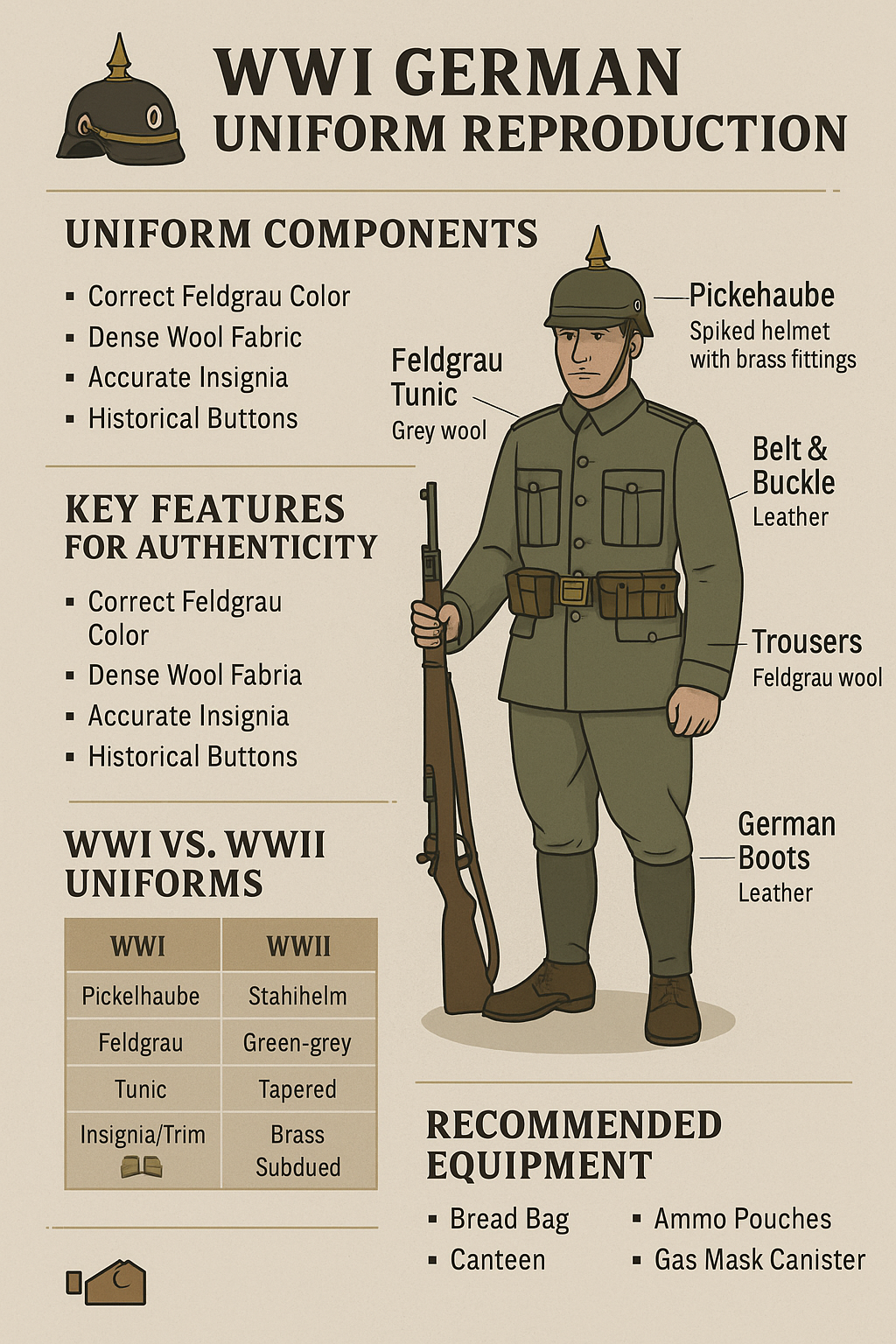
Everything You Need to Know About WW1 German Uniform Reproduction
Published on Jul 20, 2025
🪖 WW1 German Uniform Reproduction: A Collector's & Reenactor’s Guide
If you're looking for authentic WW1 German uniform reproduction pieces for reenactment, education, or collecting, you're not alone. There’s a growing global community passionate about recreating history with precision.
In this comprehensive guide, we’ll break down uniform components, how to select the right reproduction, what distinguishes WW1 from WW2 uniforms, and how to find trusted sources for high-quality gear. You’ll also find tables and visual comparisons to ensure historical accuracy in your purchases and setups.
🎯 What Is a WW1 German Uniform Reproduction?
A WW1 German uniform reproduction is a modern recreation of the Imperial German Army uniform worn during World War I (1914–1918). These uniforms are widely used for:
- Historical reenactments
- Museum displays
- WW1 film productions
- Private collections
Authentic reproductions aim to replicate the cut, fabric, stitching, insignia, and color of the original garments. Some enthusiasts even pair their outfits with WW1 reenactment equipment like rifles, bayonets, and field packs.
📋 Uniform Components Table – What to Look For
Component Description Tips for Reproduction
Pickelhaube Helmet : Spiked leather helmet worn early in the war. Ensure accurate emblems and brass trim.
Feldgrau Tunic Grey wool field tunic with buttons and rank patches. Should match historical shade and cut.
Trousers: Straight wool pants matching the tunic. Reinforced knees and correct seams are a must.
Belt & Buckle Leather belt with “Gott Mit Uns” buckle. Look for embossed, zinc or steel reproductions
German Boots High leather marching boots (Marschstiefel) Calf-height and hobnailed soles are common.
WW1 German Cap Soft cap with cockades and piping. Should be state-specific in design
🧵 The Key to Authentic Reproductions
Choosing the right WW1 German uniform reproduction means more than just grabbing the cheapest option online. Realism, durability, and historical integrity matter. Read this expert blog on Top Tips for Choosing the Perfect Imperial German Uniform Reproduction to guide your decision-making process.
Some collectors even blend items with later-era pieces, such as repro German WW2 gear for hybrid reenactments. But for an accurate WW1 portrayal, you’ll want to stick to period-specific items.
🔄 WW1 vs WW2 Replica Uniforms – What’s the Difference?
While many assume WW1 and WW2 German uniforms are the same, they're quite different in construction and visual identity.
📊 Comparison Table: WW1 vs WW2 German Uniforms
FeatureWW1 UniformsWW2 Replicas
Helmet Pickelhaube, later replaced by M16 Stahlhelm , Stahlhelm M35–M42
Color Feldgrau (field grey) Green-grey (slightly darker)
Cut & Fit Boxier with large collars , Tighter fit, more tailored
Buttons , Brass or pewter, painted steel or plastic
Accessories , Leather gear & buttons , Webbing and synthetic materials
For those looking to collect or reenact multiple eras, our curated WW2 Replica Uniform Collection includes repro German WW2 uniforms faithful to the original specs.
🛠️ WW1 Reenactment Equipment – Gear That Completes the Look
A uniform isn’t complete without its gear. Here’s what reenactors typically add:
Reenactment GearPurposeRepro Tip
Bread Bag: Carried food and personal items. Must have leather strap fittings
Canteen, carried water; leather strap carrier. Choose aluminum or tin-style finish
Entrenching Tool: Small spade for trench digging. Repros should have wooden handles and metal heads
Ammo Pouches Held rifle cartridges , Black or brown leather; 3-pouch format
Gas Mask Canister Issued later in the war Tube-shaped container with a shoulder strap
For authentic gear, check out our military-grade reproductions in the WW2 German Army Uniform Collection, which often includes accessories that match WW1 needs.
🧠 Why Authenticity Matters in Reenactment
For serious reenactors and educators, a WW1 German uniform reproduction isn’t just about the look—it’s about respect for history.
- Wearing the correct uniform reflects proper military lineage
- Helps audiences or students understand the era more clearly
- Enhances immersion in events and media productions
Explore the heritage behind these uniforms in our historical blog, The Fascinating History of German Army Uniforms – From the Pickelhaube to the SS.
🔍 What to Avoid in Poor Reproductions
❌ Red Flags✅ Why It Matters
Wrong color (blue/green shades). Authentic Feldgrau is distinct
Modern buttons or Velcro are historically inaccurate
Poor stitching, or polyester , Wool, and cotton were the materials used
Plastic insignia should be embroidered or brass
🛒 Where to Buy High-Quality WW1 German Uniform Reproductions
At Paddelaters.com, we combine historical knowledge, quality control, and SEO-driven ecommerce to bring reenactors and collectors premium options.
- Uniforms crafted with correct period materials
- Accurate insignia and trim detailing
- Accessories that match historical functionality
Explore our WW2 Uniform Section, which includes crossover gear suitable for WW1 impressions as well.
🧭 Final Thoughts – Wear History with Confidence
A WW1 German uniform reproduction is more than clothing—it’s a portal into the past. Whether you're staging a reenactment, creating educational content, or building a private collection, authenticity builds credibility.
By understanding uniform elements, choosing trusted vendors, and learning from experienced historians like Muneeb and the team at Paddelaters, you’re equipped to honor history with accuracy and style.
